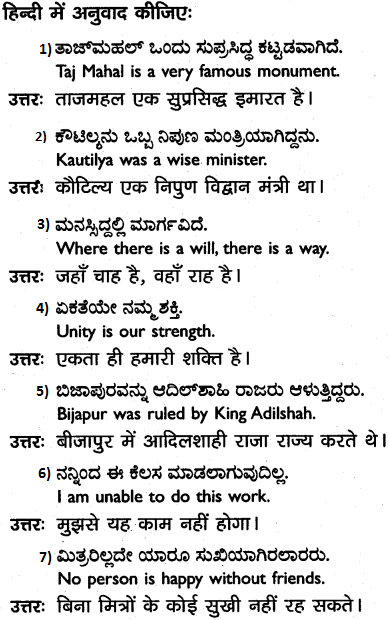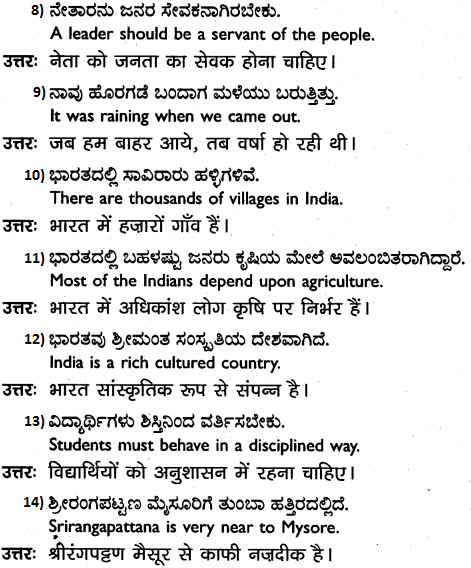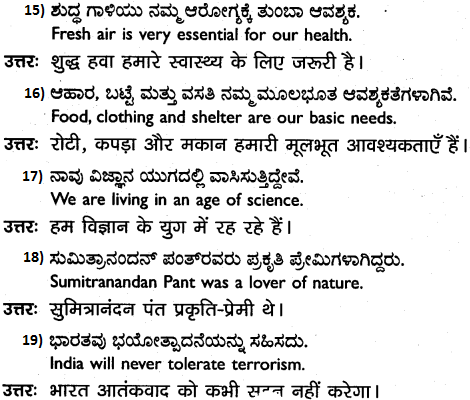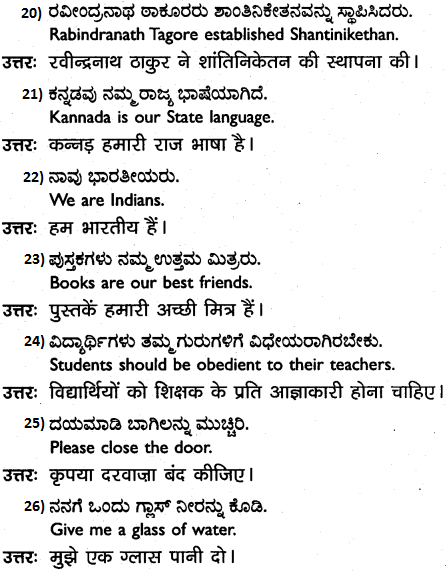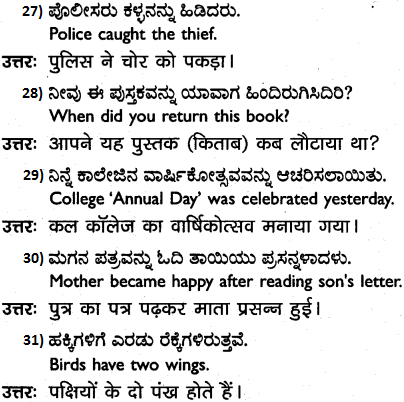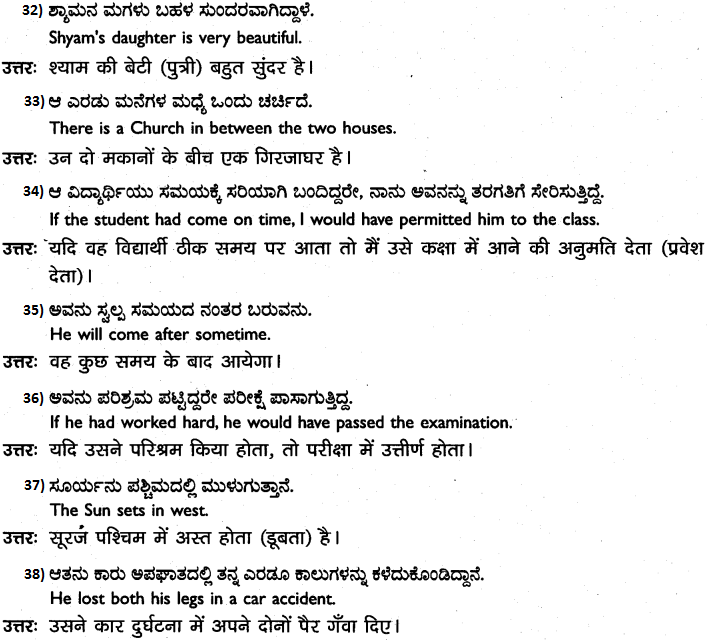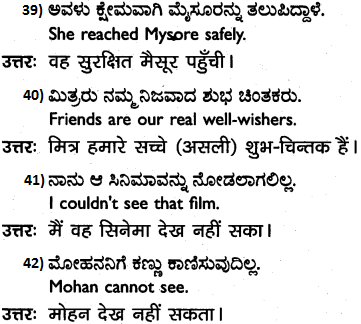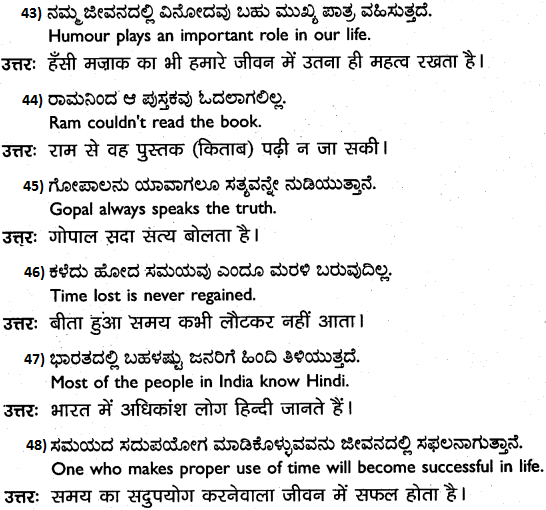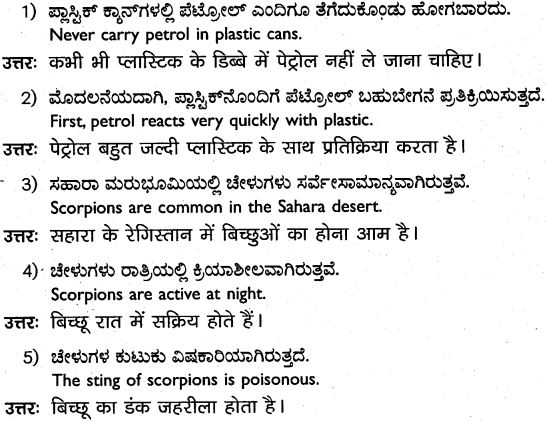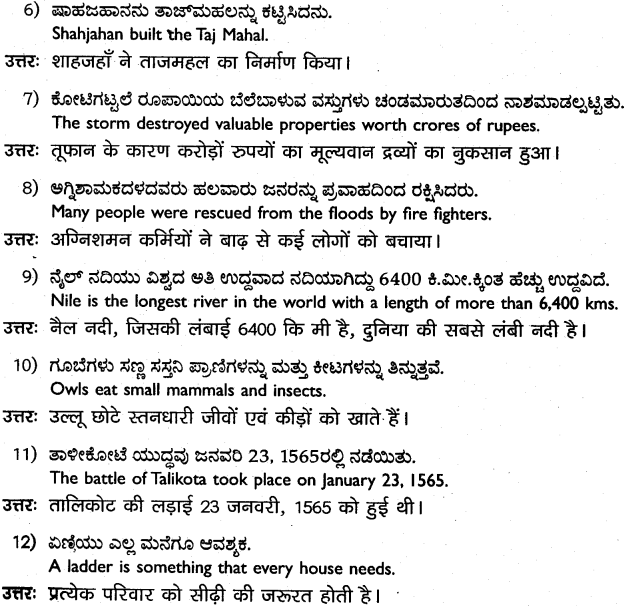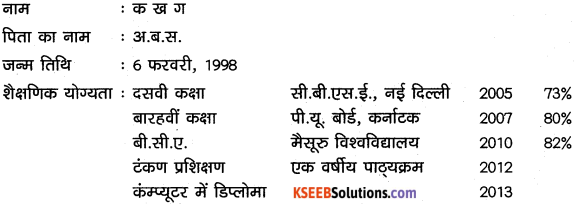You can Download Chapter 5 Rise and Spread of Christianity and Islam Questions and Answers, Notes, 1st PUC History Question Bank with Answers Karnataka State Board Solutions help you to revise complete Syllabus and score more marks in your examinations.
Karnataka 1st PUC History Question Bank Chapter 5 Rise and Spread of Christianity and Islam
1st PUC History Rise and Spread of Christianity and Islam One Mark Questions and Answers
Question 1.
Which is the biggest religion in the world?
Answer:
Christianity is the biggest religion in the world.
Question 2.
Who was the founder of Christianity?
Answer:
The founder of Christianity was Jesus Christ.
![]()
Question 3.
Which is the emblem of Christianity?
Answer:
Cross is the emblem of Christianity.
Question 4.
Which was the religious centre of Jews?
Answer:
Jerusalem was the religious centre of Jews.
Question 5.
Which God was worshipped by Jews?
Answer:
Jehovah was the God worshipped by the Jews.
Question 6.
Which was the religious text of Jews?
Answer:
The Old Testament containing the teachings, principles and religious experiences of the Jews is their religious text.
Question 7.
Who was the religious Prophet of Jews?
Answer:
Moses was the religious Prophet of Jews.
Question 8.
When was Jesus Christ born?
Answer:
Jesus Christ was born on 25th December 4 B.C.E.
![]()
Question 9.
Where was Jesus born?
Answer:
Jesus was born at Bethlehem in Judea.
Question 10.
What do you mean by Christ?
Answer:
Christ means ‘Anointed one’.
Question 11.
Who was the contemporary Roman Emperor of Jesus Christ?
Answer:
King Herod was the contemporary Roman Emperor.
Question 12.
On which hill was Jesus crucified?
Answer:
Mount Calvary at Golgotha, a hill near Jerusalem was the place where Jesus was crucified.
Question 13.
What is Easter Sunday?
Answer:
Jesus Christ is believed to have risen to life on the third day after his crucification, which was a Sunday. This day of His resurrection is celebrated as Easter Sunday.
![]()
Question 14.
Which part of the Bible contains the teachings of Jesus?
Answer:
The New Testament contains the Gospels written by his four disciples which deal with the biography of Jesus and his teachings.
Question 15.
What was Milan Edict?
Answer:
Constantine, the Emperor of Rome issued the Edict of Milan in 313 C.E., to make Christianity a legal religion in the Roman Empire.
Question 16.
Who was the first Roman Emperor to accept Christianity?
Answer:
Constantine was the first Roman Emperor to accept Christianity.
Question 17.
Who was the Roman Emperor to declare Christianity as National Religion?
Answer:
Emperor Theodisius was the Roman Emperor to declare Christianity as the national Religion in 4th century C.E.
Question 18.
Who was the first Christian missionary who came to India to spread Christianity?
Answer:
St. Francis Xavier was the first Christian missionary who came to India to spread Christianity.
Question 19.
Who Was David?
Answer:
David was a King of Judea.
![]()
Question 20.
What did Jesus call himself as?
Answer:
Jesus called himself as ‘Son of God’.
Question 21.
Which is the Holy book of Christians?
Answer:
The Holy book of Christians is the Bible.
Question 22.
Who became the second Pope?
Answer:
St. Paul became the second Pope.
Question 23.
Who spread Christianity in Kerala?
Answer:
St. Francis Xavier spread Christianity in Kerala.
Question 24.
In which style were the Churches built at the beginning of the Christian era?
Answer:
Beautiful Churches and Cathedrals were built in the Greco Roman style.
Question 25.
Who was the founder of Islam?
Answer:
Prophet Mohammed founded Islam.
Question 26.
Which is the holy place of Muslims?
Answer:
The holy place of Muslims is the Khaba at Mecca.
![]()
Question 27.
Who was the uncle of Prophet?
Answer:
Abu-Talib was the uncle of Prophet.
Question 28.
Who was the wife of Prophet?
Answer:
Khadija was the wife of Prophet.
Question 29.
On which hilly cave did Mohammed meditate?
Answer:
Mohammed meditated in a solitary cave at Hira.
Question 30.
Who was the messenger who preached the Gospels to Prophet?
Answer:
Gabriel, a messenger of God preached the holy Gospels to Prophet when he was in a trance.
Question 31.
Which was the stone worshipped by Muslims at Mecca?
Answer:
The Black stone of Khaba is worshipped by Muslims at Mecca.
![]()
Question 32.
When did the Prophet die?
Answer:
Prophet Mohammed died in 632 C.E.
Question 33.
Which is the holy book of Islam?
Answer:
The holy book of Islam is ‘Koran’ or ‘Quran’.
Question 34.
What is Kalima?
Answer:
Kalima which is one of the five pillars or principles of Islam means faith.
Question 35.
What is Namaz?
Answer:
Namaz, one of the five pillars of Islam means prayer.
Question 36.
What is Zaqqat?
Answer:
It is to give alms to the poor, which is the duty of every Muslim.
Question 37.
What is Roza?
Answer:
Roza means fasting which every Muslim should do during the holy month of Ramzan.
![]()
Question 38.
What is Hajj?
Answer:
Hajj is a Holy Pilgrimage to Mecca, which a true Muslim should undertake at least once in their lifetime.
Question 39.
Who built the Khaba?
Answer:
Abraham built the Khaba Temple for the black stone he had received from Archangel Gabriel.
1st PUC History Rise and Spread of Christianity and Islam Two Mark Questions and Answers
Question 1.
Who were the parents of Jesus?
Answer:
Joseph and Virgin Mary were the parents of Jesus.
Question 2.
Which are the two parts of the Bible?
Answer:
The two parts of the Bible are the Old Testament and the New Testament.
Question 3.
When was Jesus crucified? Who was the Roman Governor at that time?
Answer:
Jesus was crucified in 30 C.E. when Pontius Pilate was the Roman Governor.
Question 4.
What was the Resurrection of Jesus?
Answer:
Jesus Christ rose to life on the third day after his Crucification. This day is celebrated as Easter Sunday and the event is called as the Resurrection of Jesus Christ.
![]()
Question 5.
Name the two important disciples of Jesus.
Answer:
St. Peter and St. Paul were the two important disciples of Jesus.
Question 6.
Name the two Roman Emperors who tortured Christians?
Answer:
Nero and Diocletian were two of the Roman Emperors who persecuted Christians.
Question 7.
Who issued the Milan Edict? When?
Answer:
Emperor Constantine of Rome issued the Milan Edict in 313 C.E to make Christianity a legal religion in the Roman Empire.
Question 8.
Who were the two Roman Emperors who gave royal patronage to Christianity?
Answer:
Constantine and Theodisius were the two Roman Emperors who gave royal patronage to Christianity.
Question 9.
Which are the important festivals of Christians?
Answer:
Three days are celebrated as the most important festivals by Christians.
- Birthday of Jesus – Christmas
- The day of Crucification of Jesus- Good Friday
- Resurrection of Jesus- Easter Sunday.
![]()
Question 10.
Which are the two major sects of Christianity?
Answer:
Christianity is divided into 2 sects:
- Roman Catholics
- Protestants
Question 11.
What did Jesus believe in above all?
Answer:
Jesus believed in forgiveness. He emphasized up on love towards Mankind. He insisted on justice, humanity and duty.
Question 12.
What were the words of Jesus regarding service?
Answer:
Jesus said, “Service to people is service to God”. Such service is a tool for spiritual achievements.
Question 13.
Mention any two teachings of Jesus.
Answer:
The important teachings of Jesus are as follows:
- Jesus preached the existence of one God. We are his children. God is omnipotent, the King of Heaven. He is all-merciful.
- Jesus preached the fatherhood of God and the brotherhood of men. Men should live like brothers and be devoted to God.
![]()
Question 14.
What is ‘Star of East’?
Answer:
According to the New Testament, when Jesus was born, a bright star was shining in the East, which was called the ‘Star of East’.
Question 15.
What is Gospel?
Answer:
Teachings of Jesus or Revelations of Jesus Christ is called Gospel.
Question 16.
Which is the symbol of Islam and name the religious centre of Muslims?
Answer:
The symbol of Islam is Star and Crescent Moon. The religious centre of Muslims is the Mosque.
Question 17.
When and where was the Prophet born?
Answer:
Mohammed was born in 570 C.E. at Mecca in Arabia.
Question 18.
Who were the parents of Mohammed?
Answer:
Abdullah and Ameena were Mohammed’s parents.
Question 19.
Name the daughter and son-in-law of Mohammed.
Answer:
The daughter of Mohammed was Fathima and Ali was his son-in-law.
![]()
Question 20.
What is the meaning of Islam?
Answer:
Islam means ‘Submission to God Allah’. There is a wide meaning to the term ‘Islam’. It preaches to be truthful, be faithful, and to have good conduct. Islam means peace.
Question 21.
Which are the two sects of Islam?
Answer:
The two sects of Islam are the Sunnis and Shias.
1st PUC History Rise and Spread of Christianity and Islam Five Mark Questions and Answers
Question 1.
Write about the life history of Jesus.
Answer:
Jesus Christ was born on 25th December 4 B.C.E at Bethlehem in Judea. Joseph and Virgin Mary were his parents. His father was a carpenter by profession at Nazareth. The birth of Jesus and the simultaneous appearance of the Easter star made the priests to believe that Jesus was a Divine Entity. He led a simple life and was associated with the poor. Jesus, at the age of 12 went to a Jewish synagogue and surprised the people by expounding the meaning of the Jewish religious texts. He was profoundly influenced by John the Baptist and at the age of 30 was baptized by him.
He became a wandering preacher and his simple teachings gathered people around him. He travelled in and around Judea with his 12 disciples and conveyed his messages in the form of parables. His disciples recognized him as the Messiah. Jesus called himself as ‘Son of God’, which enraged the orthodox Jews. He was crucified on Friday the 3rd April 30 C.E at Mount Calvary at Golgotha, a hill near Jerusalem. His resurrection took place on the third day and he remained with his disciples for 40 days and then ascended into heaven.
Question 2.
Explain the teachings of Jesus Christ.
Answer:
The teachings of Jesus Christ are founded in the holy book of Christians, the Bible. Some of the important ones are:
- The existence of one God. We are his children. God is omnipotent, the King of Heaven. He is all-merciful.
- Jesus preached the fatherhood of God and the brotherhood of men. Men should live like brothers and be devoted to God.
- Jesus believed in forgiveness and love towards mankind. He insisted on justice, humility and duty. He said, “Love your neighbours, love your enemies, bless them who curse you and do good to those who hate you and pray for them”.
- According to Jesus, humility, purity of heart, sincerity, and fulfillment of duty were the gateway to heaven.
- Jesus said “Service to people is service to God” and such service is a tool for spiritual achievements.
- Forgiveness is a great virtue, and such persons are close to God.Thus Jesus preached simple principles which are helpful to mankind, to achieve salvation.
![]()
Question 3.
Which were the important causes for the spread of Christianity?
Answer:
The import causes for the spread of Christianity were:
1. Personality of Jesus:
The simplicity of Jesus attracted common people to him. His appeal towards poor, sinners and sufferers and his spiritual power helped in the spread of religion.
2. Simple principles:
Jesus’ principles like fraternity, compassion, forgiveness, and faith in the Kingdom of Heaven – all these made Jesus popular among the poor and the slaves.
3. Role of Apostles:
The 12 apostles played a dominant role in spreading Christianity by popularizing the principles of Jesus. Among them St. Peter and St. Paul are important. St. Peter founded a Church at Rome and became the first Pope to spread Christianity in Rome and Asia Minor. St. Peter was executed by Nero the Emperor of Rome which made him a martyr. St. Paul became the second Pope.
4. Role of Church:
The Church became the chief institute for the preservation and propagation of the faith. People believed in Church as a way to Heaven and the pope as the representative of God. Despite persecutions, Christianity gained popularity.
5. Role of Constantine:
The persecution of the Christians stopped when Constantine became the Emperor of Rome. He built a new city called Constantinople and dedicated it to virgin Mary. He issued the Edict of Milan, which made Christianity a legal religion in the Roman Empire and gave permission to the Christian missionaries to spread Christianity in the East. Under Emperor Theodisius in the 4th century C.E., Christianity became the state religion.
Question 4.
What is Resurrection of Jesus?
Answer:
The birth of Jesus and the simultaneous appearance of the Star of East made the priests to believe that Jesus was a divine Entity. He led a simple life and was associated with the poor. Jesus was profoundly influenced by John the Baptist and was baptized by John at the age of 30. He became a wandering preacher and his simple teachings and messages in the form of parables attracted people who flocked around him. He travelled in and around Judea with his 12 disciples, who recognized him as Messiah.
Jesus called himself as Son of God which enraged the orthodox Jews. Jesus was crucified on Friday the 3rd April 30 C.E. on Mount Calvary at Golgotha, which is celebrated as Good Friday every year. His followers wept at his grave. It is believed that Christ rose to life on the third day after the death. This day is celebrated as Easter Sunday. This event is called as Resurrection of Christ. After the Resurrection, Jesus remained with his disciples for 40 days and then ascended into heaven. Thereby he is said to have proved that he was the Son of God.
![]()
Question 5.
Write about the Spiritual messages of Jesus.
Answer:
Spiritual Message of Jesus to his followers is given in the form of a sermon. ‘The Sermon on the Mount’. It runs as follows.
- Blessed are the poor in spirit, for theirs is the Kingdom of Heaven.
- Blessed are they that mourn, for they shall be comforted. There are some more messages along the same lines for the people to follow.
- Jesus gave the message of the love and compassion. He said “Do not commit adultery”, “Do not steal”, and “Give respect to Elders”. These are simple paths to emancipation.
- Jesus said, “Service to people is service to God”. Such service is a tool for spiritual achievements.
- Jesus preached the existence of one God. We are his Sons. God is omnipotent, the King of Heaven. He is all-merciful.
- Jesus preached the Fatherhood of God and Brotherhood of men. Men should live like brothers and be devoted to God.
- Jesus believed in forgiveness. He insisted on Justice, Humility and Duty. He said, “Love your neighbours, love your enemies, bless them who curse you and do good to them who hate you and pray for them”.
- According to Jesus, humility, purity of heart, sincerity, and fulfillment of duty were the gateway to heaven.
- Forgiveness is a great virtue; Persons practicing it are close to God.
Thus Jesus preached simple principles which are helpful to mankind, to achieve salvation. Teachings of Jesus are found in the holy book of Christians, the ‘Bible’.
Question 6.
Mention the role of the Apostles in the spreading of Christianity.
Answer:
The 12 apostles played a dominant role in spreading Christianity by popularizing the principles of Jesus. Among them St. Peter and St. Raul are important. St. Peter founded a church at Rome and became the first Pope to spread Christianity in Rome and Asia Minor. St. Peter was executed by Nero, the Emperor of Rome, which made him a martyr. St. Paul became the second Pope. He spread Christianity in Rome, Greece, Macedonia, Athens, Philipi, and Damascus.
He established Churches to propagate the Principles of Jesus. He is called as the ‘Second Jesus’. The Martyrdom inspired many like St. Mathew, St. Mark, St. Luke and St. John. They consolidated the Gospels of Jesus. St. Thomas came to India in 78 C.E. and carried his work in the Malabar region. The efforts of St. Augustine in England, St. Patrick in Ireland and St. Bonephase in Germany led to the spread of Christianity.
![]()
Question 7.
Explain the background for the rise of Islam?
Answer:
Islam is one of the important religions of the world. Islam rose from the Arabian Peninsula, situated in South West Asia. This land was inhabited by Arabs. The land was a desert. Mecca and Madina were the only two important cities in Arabia. As rainfall was scanty, cultivation was not possible. So 80% of Arabs were nomads. They tended camels which provided them milk and meat. They cultivated dates, apricots, pomegranates, lemons, orange, and bananas.
Camel and horse were the means of transport. They led a hard life and quarrels between tribes for Oasis and fodder were the order of the day. People were socially and economically backward. Tribes looted the commercial caravans and plundered cities. Theft, robbery, and gambling were common.
They worshipped more than 360 idols. Blind faith and animal sacrifice existed in the society. In spite of these ugly traits, Arabs were held together by a common faith – the shrine of Khaba at Mecca. They did not have a common social, moral, cultural and religious framework. Prophet Mohammed founded Islam and organised Muslims under a single religious framework.
Question 8.
Write about the life history of Mohammed.
Answer:
Mohammad was born in 570C.E. at Mecca in Arabia. Abdullah and Ameena were his parents. He belonged to the Qureshi tribe of Mecca. He lost his parents early in his childhood and was brought up by his uncle Abu-Talib. Due to poverty, he could not receive any formal education, but he was trained to look after sheep and camels.
He was known for his honesty and sincerity and the comerchants called him as Amin – one who is reliable. He worked for a rich widow, Khadija and later married her, who was 15 years elder to him. They had two sons and two daughters. Daughter Fathima survived and other three died. She was given in marriage to Ali. Mohammed led a normal married life up to age of forty.
He spent most of his time in meditation and fasting. He was also seriously thinking about the social and religious evils of the Arabs. While meditating at the Hira cave, Gabriel a messenger of God preached him the holy Gospels while he was in a trance. Mohammed felt the impact of the Divine message of God.
He also realized that he was the chosen one, and had a great mission to fulfill. His wife, son-in-law, daughter, friend Abu-Bakr and his servant Syed Mohammed were his first disciples. He declared “There is no God but Allah and Mohammed is his prophet”.
He started teaching the principles of the new faith to the people of Mecca. He criticized the meaningless ceremonials like Idol worship, polytheism, and superstitions. He preached the purity of life, truth, and faith in Allah. He said Allah is Omnipotent and kind to all.
He preached Allah would reward the just and punish the wicked. There was opposition to him from the idol worshippers and he took refuge in Madina and his secret journey is known as Hejira. He was welcomed there. Later he returned to Mecca and Arabs accepted his principles. He died in 632 C. E.
![]()
Question 9.
Write about the five pillars of Islam.
Answer:
A true believer in Islam (Muslim) has to perform certain duties which are the pillars of Islam or principles of Islam. They are Kalima, Namaz, Zaqqat, Roza and Hajj.
1. Kalima:
It means faith. He should profess his faith in God Allah and his messenger, Mohammed-his Prophet. Every Muslim was required to recite the Muslim Credo. “There is no God but Allah, everyone should surrender to him, have faith and respect him”. This is an important message of the Quran.
2. Namaz:
It means prayer. Every Muslim has to pray five times a day at dawn, shortly after midday, late afternoon, at sunset and at bedtime. He is expected to clean himself and turn towards Mecca and offer prayer. Every Friday one has to go to the Mosque to offer prayer and listen to the discussion on the Quran. Prayer is the best method to please God and getting one’s sins pardoned.
3. Zaqqat:
It is to give alms to the poor Almsgiving is another duty of every Muslim. One should be honest and sincere. He has to give 2.5% of his income in charity for the promotion of religion and help the poor. Islam prohibits begging as a profession.
4. Roza:
Every Muslim must fast during day time in the holy month of Ramzan.
5. Hajj:
Every Muslim is obliged to perform pilgrimage to Mecca once in their lifetime.
Question 10.
What are the main teachings of Mohammed?
Answer:
Prophet Mohammad declared “There is no God but Allah and Mohammad is his Prophet”. He criticized the meaningless ceremonials like Idol worship, polytheism, and superstitions among Arabs. He preached the purity of life, truth, and faith in Allah. He preached that Allah would reward the just and punish the wicked.
He said, “Allah is all-merciful, all-wise and all-powerful”. The new faith that Mohammad preached was called ‘Islam’ which means “Submission to God Allah’. Islam preaches to be truthful, be faithful and to have good conduct. It preaches equality and condemns slavery. Mohammad advocated the following five pillars or Principles of Islam to be followed by all Muslims.
1. Kalima:
It means faith. Every Muslim should profess his faith in Allah and Mohammad. Namaz – It means prayer. Every Muslim has to pray five times a day. Prayer is the best method to please God and get one’s sins pardoned.
2. Zaqqat:
It means almsgiving. Muslims should be honest and sincere. They should give 2.5 % of what they earn in charity. The purpose is to bring economic equality between the rich and the poor.
3. Roza:
It means fasting. Every Muslim should fast in the month of Ramzan, from morning to dusk. Fasting brings purity of heart. It balances the desires, controls one’s habits and creates confidence towards deliverance. It is a proper training to acquire good character.
4. Hajj:
It is the holy pilgrimage to Mecca. True Muslims should undertake Hajj at least once in their lifetime.
There were other moral codes advocated by the prophet.
He prohibited gambling, drinking, adultery, and use of pork. He preached the democratic principles of equality and universal brotherhood. He also advocated important moral values like respect for women, parents, and kindness to slaves and animals.
1st PUC History Rise and Spread of Christianity and Islam Ten Mark Questions and Answers
Question 1.
Explain the life and teachings of Jesus Christ.
Answer:
The founder of Christianity was Jesus Christ. He was a Jew born on 25th December 4 B.C.E. at Bethlehem in Judea. Joseph and Virgin Mary were his parents. By profession, his father was a carpenter at Nazareth. The birth of Jesus and the simultaneous appearance of the Star of East made the priests to believe that Jesus was a divine Entity.
He led a simple life and was associated with the poor. At the age of 12, he went to a Jewish synagogue and expounded the meaning of the difficult Jewish religious texts. Jesus was profoundly influenced by John the Baptist who baptized him at the age of 30. Jesus became a wandering preacher.
His simple teachings and messages in the form of parables attracted people who flocked around him. He travelled in and around Judea with his 12 disciples, who recognized him as the Messiah. Jesus called himself as the Son of God, which enraged the orthodox Jews.
His crucification took place on the 3rd April 30 C.E., at Mount Calvary at Golgotha, a hill near Jerusalem. His resurrection took place 3 days later, after which he remained with his disciples for 40 days and then ascended into heaven.
The teachings of Jesus are found in the holy book of Christians, namely the Bible.
- Jesus preached the existence of one God. We are his sons. God is omnipotent, the King of Heaven. He is all-merciful.
- Jesus preached the fatherhood of God and brotherhood of men. Men should live like brothers and be devoted to God.
- Jesus believed in forgiveness and love towards mankind. He insisted on justice, humility and duty. He said, “Love your neighbours, love your enemies, bless them who curse you and do good to those who hate you and pray for them”.
- According to Jesus, humility, purity of heart, sincerity, and fulfillment of duty were the gateway to heaven.
- Jesus said, “Service to people is service to God”. Such a service is a tool for spiritual attainments.
- Forgiveness is a great virtue and persons blessed with that are close to God.
Jesus preached such simple principles, which are helpful to mankind, to achieve salvation.
![]()
Question 2.
What were the causes for the spread of Christianity? Write about its influence.
Answer:
The important causes for the spread of Christianity were:
1. Personality of Jesus:
The simplicity of Jesus attracted common people. His appeal towards the poor, sinners and sufferers and his spiritual power helped in the spread of religion.
2. Simple principles:
Jesus’ principles like fraternity, compassion, forgiveness, and faith in the Kingdom of Heaven – all these made Jesus popular among the poor and the slaves.
3. Role of Apostles:
The 12 apostles played a dominant role in spreading Christianity by popularizing the principles of Jesus. Among them St. Peter and St. Paul are important. St.Peter founded a Church at Rome and became the first Pope to spread Christianity in Rome and Asia Minor. St. Peter was executed by Nero-the Emperor of Rome which made him a martyr. St. Paul became the second Pope.
4. Role of Church:-
The Church became the chief institute for the preservation and propagation of the faith. People believed in Church as a way to Heaven and Pope as the representative of God. Despite persecutions, Christianity gained popularity.
5. Role of Constantine:
The persecution of the Christians stopped when Constantine became the Emperor of Rome. He built a new city called Constantinople and dedicated it to virgin Mary. He issued the Edict of Milan, which made Christianity a legal religion in the Roman Empire and gave permission to the Christian missionaries to spread Christianity in the East. Under Emperor Theodisius in the 4th century C.E., Christianity became the state religion.
Question 3.
Explain the rise and spread of Christianity.
Answer:
The founder of Christianity was Jesus Christ. He was a Jew born on 25th December 4 B.C.E. at Bethlehem in Judea. Joseph and Virgin Mary were his parents. The birth of Jesus and the simultaneous appearance of the Easter star made the priests to believe that Jesus was a divine Entity.
He led a simple life and was associated with the poor. At the age of 12, he went to a Jewish synagogue and expounded the meaning of the difficult Jewish religious texts. Jesus was profoundly influenced by John the Baptist who baptized him at the age of 30. Jesus became a wandering preacher.
His simple teachings and messages in the form of parables attracted people who flocked around him. He travelled in and around Judea with his 12 disciples, who recognized him as the Messiah. Jesus called himself as the Son of God, which enraged the orthodox Jews.
His crucification took place on the 3rd April 30 C.E., at Mount Calvary at Golgotha, a hill near Jerusalem. His resurrection took place 3 days later, after which he remained with his disciples for 40 days and then ascended into heaven.
The teachings of Jesus are found in the holy book of Christians, namely the Bible.
- Jesus preached the existence of one God. We are his sons. God is omnipotent, the King of Heaven. He is all-merciful.
- Jesus preached the fatherhood of God and brotherhood of men. Men should live like brothers and be devoted to God.
- Jesus believed in forgiveness and love towards mankind. He insisted on justice, humility and duty. He said, “Love your neighbours, love your enemies, bless them who curse you and do good to those who hate you and pray for them”.
- According to Jesus, humility, purity of heart, sincerity, and fulfillment of duty were the gateway to heaven.
- Jesus said, “Service to people is service to God”. Such a service is a tool for spiritual attainments.
- Forgiveness is a great virtue and persons blessed with that are close to God.
Thus Jesus preached simple principles which are helpful to mankind, to achieve salvation.
Spread of Christianity
1. Personality of Jesus:
The simplicity of Jesus attracted common people. His appeal towards the poor, sinners and sufferers and his spiritual power helped in the spread of religion.
2. Simple principles:
Jesus’ principles like fraternity, compassion, forgiveness, and faith in the Kingdom of Heaven – all these made Jesus popular among the poor and the slaves.
3. Role of Apostles:
The 12 Apostles played a dominant role in spreading Christianity by popularizing the principles of Jesus. Among them St. Peter and St. Paul are important. St. Peter founded a Church at Rome and became the first Pope to spread Christianity in Rome and Asia Minor. St. Peter was executed by Nero-the Emperor of Rome which made him a martyr. St. Paul became the second Pope.
Role of Church. The Church became the chief institute for the preservation and propagation of the faith. People believed in Church as a way to Heaven and Pope as the representative of God. Despite persecutions, Christianity gained popularity.
5. Role of Constantine:
The persecution of the Christians stopped when Constantine became the Emperor of Rome. He built a new city called Constantinople and dedicated it to Virgin Maty. He issued the Edict of Milan, which made Christianity a legal religion in the Roman Empire and gave permission to the Christian missionaries to spread Christianity in the East. Under Emperor Theodisius in the 4th century C.E., Christianity became the state religion.
![]()
Question 4.
Explain the life and teachings of Prophet Mohammed.
Answer:
Mohammed was born in 570 C.E. at Mecca in Arabia. Abdullah and Ameena were his parents, He belonged to the Qureshi tribe of Mecca. He lost his parents early in his childhood and was brought up by his uncle Abu-Talib. Due to poverty, he could not receive any formal education, but he was trained to look after sheep and camels.
He was known for his honesty and sincerity. As a youth, he spent most of his time in travelling with the caravans. The comerchants called him as Amin – one who is reliable. He married Khadija, a widow, who was 15 years elder to him. They had two sons and two daughters. Daughter Fathima survived and other three died. She was given in marriage to Ali. Mohammed led a normal married life up to the age of forty.
He spent most of his time in meditation and fasting. He was also seriously thinking about the social and religious evils of the Arabs. While meditating at the Hira cave, Gabriel a messenger of God preached him the holy Gospels while he was in a trance.
Mohammed realized the impact of the Divine message of God. He also realized that he was the chosen one, and had a great mission to fulfill. His wife, son-in-law, daughter, friend Abu-Bakr and his servant Syed Mohammed were his first disciples. He declared “There is no God but Allah and Mohammed is his prophet”
He started teaching the principles of the new faith to the people of Mecca. He criticized the meaningless ceremonials like Idol worship, polytheism, and superstitions among Arabs. He preached the purity of life, truth, and faith in Allah. He said Allah is Omnipotent and kind to all.
He preached Allah would reward the just and punish the wicked. Those who surrender themselves to the will of God were Muslims. His followers called him Prophet. Mohammed declared he was the prophet chosen by Allah to reveal his message to mankind. He said, “Allah was all-merciful, all-wise and all-powerful”.
Question 5.
Explain the foundation and the five pillars of Islam.
Answer:
A true believer in Islam (Muslim) has to perform certain duties which might be called pillars of Islam or principles of Islam. They are Kalima, Namaz, Zaqqat, Roza and Hajj.
1. Kalima:
It means faith. Muslims should profess their faith in God Allah and his messenger, Mohammed – his Prophet. Every Muslim was required to receive the Muslim Credo. “There is no God but Allah, everyone should surrender to him, have faith and respect him”. This is an important message of the Quran.
2. Namaz:
It means prayer. Every Muslim has to pray five times a day, namely at dawn, shortly after midday, late afternoon, at sunset and at bedtime. He is expected to clean himself and turn towards Mecca and offer prayer. Every Friday, one has to go to Mosque to offer prayer and listen to the discussion on Quran. Prayer is the best method to please God and getting one’s sins pardoned.
3. Zaqqat:
It is to give alms to the poor. Almsgiving is another duty of every Muslim. One should be honest and sincere. He has to give 2.5% of his income in charity for the promotion of religion and help the poor.
4. Roza:
It means fasting. Every Muslim should fast in the month of Ramzan. One should fast for 29 to 30 days from morning to dusk. Fasting brings in purity of heart. It balances the desires, it controls one’s habits and it creates a confidence towards deliverance. It proves that we ar6 not slaves of our habits. It is a proper training to acquire good character. Sick people, travelers, children, old and nursing mothers are exempted.
Hajj:
It is a Holy pilgrimage to Mecca. A true Muslim should undertake pilgrimage to the holy city of Mecca at least once in his lifetime. For such people, heaven is opened. Hajj means renewal of submission to God Allah. As Kashi is to Hindus, Vatican City is to Christians, so is Mecca to Muslims. Door to Mecca is open from October to December. Millions of Pilgrims come from all over the world. When Prophet Mohammed prohibited idol worship at Khaba, it became the holy prayer hall to Muslims.
![]()
Question 6.
Explain in detail the rise and spread of Islam.
Answer:
Islam is one of the important religions of the world. Islam rose from Arabian Peninsula, situated in South West Asia. This land was inhabited by Arabs. The land was a desert. Mecca and Madina were the only two important cities in Arabia. As Rainfall was scanty, cultivation was not possible. So 80% of Arabs were nomads. They tended camels which provided them milk and meat.
They cultivated dates, apricots, pomegranates, lemons, orange, and bananas. Camel and horse were the means of transport. They led a hard life and quarrels between tribes for Oasis and fodder were the order of the day. People were socially and economically backward. Tribes looted the commercial caravans and plundered cities. Theft, robbery, and gambling were common.
They worshipped more than 360 idols. Blind faith and animal sacrifice existed in the society. In spite of these ugly traits, Arabs were held together by a common faith-the shrine of Khaba at Mecca. They did not have a common social, moral, cultural and religious framework.
Prophet Mohammed founded Islam and organised Muslims under a single religious framework. Mohammed was born in 570 C.E. at Mecca in Arabia. Abdullah and Ameena were his parents. He belonged to the Qureshi tribe of Mecca.
He lost his parents early in his childhood and was brought up by his uncle Abu-Talib. Due to poverty, he could not receive any formal education, but he was trained to look after sheep and camels. He was known for his honesty and sincerity. As a youth, he spent most of his time in travelling with the caravans.
The co¬merchants called him as Amin-one who is reliable. He married Khadija, a widow, who was 15 years elder to him. They had two sons and two daughters. Daughter Fathima survived and other three died. She was given in marriage to Ali. Mohammed led a normal married life up to the age of forty.
He spent most of his time in meditation and fasting. He was also seriously thinking about the social and religious evils of the Arabs. While meditating at the Hira cave, Gabriel a messenger of God preached him the holy Gospels while he was in a trance. Mohammed realized the impact of the Divine message of God.
He also realized that he was the chosen one, and had a great mission to fulfill. His wife, son-in-law, daughter, friend Abu-Bakr and his servant Syed Mohammed were his first disciples. He declared “There is no God but Allah and Mohammed is his prophet”.
He started teaching the principles of the new faith to the people of Mecca. He criticized the .meaningless ceremonials like Idol worship, polytheism, and superstitions among Arabs. He preached the purity of life, truth, and faith in Allah. He said Allah is Omnipotent and kind to all.
He preached Allah would reward the just and punish the wicked. Those who surrender themselves to the will of God were Muslims. His followers called him Prophet. Mohammed declared he was the prophet chosen by Allah to reveal his message to mankind. He said, “Allah was all-merciful, all-wise and all-powerful”.
